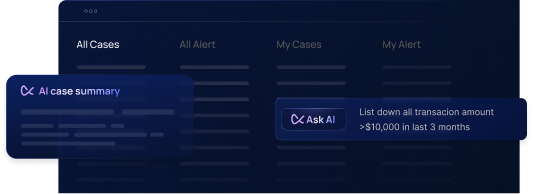Digital technology is rewriting the rulebook for nearly every industry at an unprecedented pace, and Anti-Money Laundering (AML) compliance is increasingly becoming intricate. Financial criminals are getting smarter and more creative. This makes it harder for banks and other financial institutions to spot and stop illegal activities.
With the advent of Artificial Intelligence (AI), AML processes have never had these many possibilities to become more efficient and effective. It has empowered AML teams with the ability to detect suspicious activities faster, more accurately, spot patterns humans might miss, work non-stop, and on a much larger scale than ever before. But with great power comes great responsibility, and the use of AI in AML compliance brings both exciting opportunities and unique challenges that financial institutions must manage.
In this article, we'll look at how AI is changing AML compliance, the benefits and challenges it brings, and how financial institutions can harness its power responsibly.
The AI Revolution in AML Compliance
AML compliance is a set of rules and actions that financial institutions must follow to prevent, detect, and report money laundering activities. The goal is simply to stop bad actors from using the financial system for illegal purposes.
A typical AML compliance process ranges from KYC, CDD, transaction monitoring, down to suspicious activity reporting. These parts work together to create a strong defense against money laundering. But with AI, we can make this defense even stronger with less work.
For instance, conventional systems of transaction monitoring are based on rules that the financial institutions establish, to tag a particular transaction while executing it; viz. size or frequency. These are traditional transaction monitoring systems using rule-based methods; financial institutions flag transactions against predetermined criteria. In reality, this usually translates into a handful of false positives that overwhelm compliance teams with notifications and make it difficult, if not impossible, to identify the real threats.
AI systems can process vast amounts of transaction data in real-time. This rapid analysis enables financial institutions to identify and respond to potential money laundering activities much more quickly than traditional methods allow. This also translates to cost savings, less wasted time and more effective crime-fighting.
Key AI Technologies in AML Compliance
Machine learning
Machine learning is a key component of AI that excels at identifying patterns in complex datasets. In the context of AML, this could mean training a system on historical transaction data to spot unusual patterns that might go unnoticed by human analysts or rule-based systems. Machine learning's ability to process and analyze vast amounts of data in real-time makes it an invaluable tool that financial institutions can leverage to enhance their ability to detect, prevent, and respond to money laundering activities more effectively. Here’s why:
- Anomaly Detection: Machine learning algorithms can establish baseline behaviours for individual customers, accounts, or transaction types. This enables the system to quickly identify deviations from normal patterns, potentially indicating suspicious activity.
- Network Analysis: Sometimes, criminals spread their activities across different accounts or banks, making it very difficult for human analysts to detect. By analyzing relationships between multiple accounts and transactions, machine learning can uncover hidden connections that may signal coordinated money laundering efforts. This capability is particularly valuable in detecting complex schemes that span across different financial institutions or jurisdictions.
- Adaptive Learning: AI systems continuously learn from new data and feedback. As new money laundering techniques emerge, machine learning models can quickly pick up on new patterns and continuously update and refine their detection criteria. This adaptability allows AML systems to stay current with evolving criminal strategies without requiring constant manual updates.
- Predictive Capabilities: By analyzing historical data and current trends, machine learning can predict potential future money laundering activities. This proactive approach enables financial institutions to implement preventive measures before illicit transactions occur.
- Reduction of False Positives: Machine learning algorithms can significantly reduce the number of false positive alerts by learning from historical data and improving their accuracy over time. A compelling example of this is Flagright's AI forensics feature which has helped financial institutions reduce false positives by 90% or more. This improvement allows AML teams to focus their efforts on genuine threats rather than wasting time on benign transactions.
Natural language processing
Natural Language Processing (NLP) is another AI tool that's changing AML. It helps computers understand and analyze written language.
- Document Review: NLP can quickly read and understand large volumes of text documents, including contracts, emails, and reports. This accelerates the review process and helps identify potential risks or compliance issues more efficiently.
- Enhanced Due Diligence: NLP can extract relevant information from news articles, social media, and other public sources to build more comprehensive risk profiles for customers and transactions.
- Automated Reporting: By analyzing and summarizing complex data, NLP assists in generating clear, concise reports for regulatory compliance and internal decision-making.
- Sentiment Analysis: NLP can analyze the tone and context of communications, helping to identify potential red flags in customer interactions or internal communications.
By leveraging NLP, financial institutions can significantly improve the speed and accuracy of their AML processes, particularly in areas involving large amounts of unstructured text data. This technology allows for more thorough and efficient compliance checks while reducing the manual workload on AML teams.
Predictive analytics
Predictive analytics is a powerful tool in AML compliance that uses historical data, statistical algorithms, and machine learning to forecast potential risks and outcomes. Its application in AML offers several key advantages:
- Proactive Risk Management: Predictive analytics enables AML teams to anticipate potential money laundering activities before they occur. By analyzing patterns and trends in historical data, these systems can identify emerging risks and flag suspicious behaviors early. This shift from reactive to proactive risk management significantly enhances the effectiveness of AML efforts.
- Smarter Resource Allocation: By predicting where risks are highest, AML teams can prioritize their efforts more effectively. This targeted approach ensures that limited resources are deployed where they're most needed, improving overall efficiency and effectiveness of AML operations.
- Scenario Planning: Predictive models can simulate various "what-if" scenarios, allowing AML teams to prepare for a wide range of potential money laundering tactics. This capability helps financial institutions stay ahead of evolving criminal strategies and adapt their defenses accordingly.
- Dynamic Risk Scoring: AI can analyze a wide range of data points to create more accurate and dynamic risk profiles for customers and transactions. This enables more effective allocation of AML resources and more targeted scrutiny of high-risk activities. This can also impact consumer experience positively; with AI handling the heavy lifting, financial institutions can onboard good customers faster. This means happier customers and more business. In addition, it helps financial institutions demonstrate to regulators that they are taking a proactive, risk-based approach to AML compliance.
Implementing predictive analytics in AML usually should require a significant investment in data infrastructure, analytical tools, and skilled personnel. However, Flagright’s no-code risk scoring engine allows you to enjoy these essential components with a single API integration for less. Our robust and customizable risk scoring algorithm helps financial institutions automate customer risk assessment while delivering high efficiency and regulatory compliance.
The Benefits of AI in AML Compliance
With so many advantageous sides to integrating AI into AML compliance, this can actually revolutionize the way financial institutions perform this process, or even automate compliance.
- Increased efficiency: Application of AI to such time-consuming tasks as monitoring transactions and KYC enables teams in compliance to deal with high-risk cases and strategic decision-making. It highly saves on costs since a lot less operational burden is put on an institution.
- More Accurate: AI systems could process massive volumes of data in real time in order to detect the patterns that hint at possibly suspicious behavior. This will, therefore, significantly minimize false positives and make certain that compliance teams are alerted about actual threats, not just noise.
- Scalability: With increasing size and volumes of transactions by financial institutions, AI will scale to meet the extra load with much ease. This is especially true in today's globalized economy, where institutions are dealing with cross-border transactions and an increased complexity of financial networks.
- Continuous Learning and Adaptation: What is probably most powerful about AI, in fact, is its very potential for learning and adaptation over time. Machine learning algorithm performance constantly improves with time as more data is fed into it
Challenges in Implementing AI for AML Compliance
While AI does come with several advantages, its adoption is not without many pitfalls for AML compliance by financial institutions.
- Data quality and availability: The effectiveness of AI in AML largely depends on the quality and availability of data. Inconsistencies and incompleteness in the data may lead to inaccuracies of the results, therefore eroding the efficiency of AI-driven AML systems.
- Explainability and Regulatory Compliance: Many AI models have been likened to "black boxes" because it's hard to understand how they make decisions. This can be a problem when there is a need to explain to regulators exactly how and why certain actions were taken. With Flagright's AI copilot, analysts can automate AML investigations with natural language queries and understand the precise rationale behind AML decisions.
- Integration with Existing Systems: Implementing AI in established AML frameworks can be technically challenging because many financial institutions rely on older systems that may not easily integrate with modern AI solutions. Furthermore, compliance teams may struggle to adapt to new AI-driven processes, leading to resistance or misuse.
The Future of AI-Driven AML Compliance
As AI technologies continue to evolve, financial institutions that fail to adapt risk falling behind more innovative competitors. The future of AML compliance is being shaped by advanced AI systems capable of detecting even the most complex money laundering activities in real time. This transformation is redefining the structure of compliance teams, emphasizing data science and AI expertise alongside traditional regulatory knowledge. Adopting intelligent financial compliance software empowers institutions to stay ahead of emerging risks while enhancing efficiency and accuracy in their compliance operations.
Financial institutions that can more quickly adopt AI-driven AML compliance will be better positioned to deal with the never-ending upward spiral of financial crimes' challenges.
Our CTO, Madhu G Nadig, has discussed with Roberto Popolizio of Website Planet what makes Flagright’s vision and approach to compliance unique.
Conclusion
The benefits of AI in AML compliance are clearly manifested in terms enhanced transaction monitoring capabilities, reduced false positives, improved operational efficiency, and continuous adaptation to new threats. This represents a significant leap forward in the fight against financial crime, allowing financial institutions to dramatically improve their ability to detect and prevent money laundering activities.
For financial institutions, embracing AI in AML compliance is no longer optional—it's a necessity to stay ahead of increasingly sophisticated financial criminals and meet growing regulatory expectations. However, this adoption must be done thoughtfully, with careful consideration of the challenges and a commitment to ethical implementation.
For financial institutions, embracing AI in AML compliance is no longer optional—it's a necessity to stay ahead of increasingly sophisticated financial criminals and meet growing regulatory expectations. However, this adoption must be done thoughtfully, with careful consideration of the challenges and a commitment to ethical implementation. Integrating AI Forensics into this process enhances transparency and accountability, ensuring that every decision made by AI systems in compliance workflows can be traced, audited, and validated.
Contact us for a demo and discover how Flagright can transform your AML compliance processes.
About the Author
Joseph Ibitola leads global demand generation at Flagright, an AI-native transaction monitoring and AML compliance platform. He drives marketing strategy, campaigns, and growth initiatives that help financial institutions adopt stronger compliance frameworks and reduce fraud risk. With expertise spanning fraud prevention, AML compliance, and financial risk management, Joseph also develops thought leadership and educational resources that position Flagright as a trusted partner to the finance industry.




.svg)





















